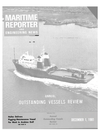
Page 28: of Maritime Reporter Magazine (December 1981)
Read this page in Pdf, Flash or Html5 edition of December 1981 Maritime Reporter Magazine
Outstanding Vessels
Review — Seabex One (continued from page 36) system, which uses data ob- tained principally from an iner- tial platform, an acoustic refer- ence system, and two taut wires.
The Seabex One wires are at- tached to an above-water part of the structure near which it is station keeping, as contrasted to other taut-wire systems that are linked to weights on the sea floor. The multiple data sources ensure a safety margin in the event any part of the system breaks down.
Power for the electrical pro- pulsion is supplied by five auxil- iaries, each consisting of an MAK 8M332AK engine and an ADG generator, producing a total out- put of 6,450 kw, using fuel of 30 cSt (200 sec. Redwood), and an emergency generator set of 300 kw.
Two engine rooms are needed to house the equipment and a large control room is situated on the lower 'tweendeck above the control room. There are acccom-
SIMPLY THE MOST VERSATILE SATELLITE [•>j 11A i [«f: i • ttiit :Mr.]
No Marisat terminal ever looked like this. Because no Marisat terminal was ever designed to do so much.
The ESZ-8000 Satellite Commu- nicator gives you all of the fast, high- quality voice, telex, data and facsimile services offered by the new Inmarsat network. And it gives them to you in a simple, easy-to-use format.
You Can SeeThe Difference. The
ESZ-8000 is the first to bring you a fully integrated cathode ray tube (CRT) screen as standard equipment.
The CRT automatically prompts all procedures and provides you with a continuous display of system status information. It also functions like a word processor so you can compose and edit telex messages right on the screen, then send them on command to any location.
AllControls Within Easy Reach.
Only the telephone, teleprinter and compact Operators Console need to be located in the radio room. Since all main functions are controlled through the Operators Console, the Central
Electronics ^^^^^^^^^^^^^^^
Unit can be installed remotely.
The Satellite Communicator
ThatGrows With You. The ESZ-8000 is built with room to grow so you can expand capabilities in the future by simply adding plug-in circuit boards.
Optional data interfaces can link your shipboard and shoreside computers to give you a fleetwide management in- formation system. And the expanded memory option can put a total com- munications library at your disposal.
Built With Experience And
Backed By Support. Compare the
ESZ-8000 with any other shipboard satellite communications terminal. Its versatility and simplicity will convince you. So will the price. And so will the
Navidyne standards behind it. Navi- dyne's international network of agents assures you of fast shipboard repair in virtually any major port.
Find out more about the ESZ- 8000. Write or call fcl JtwiiwAlf
Navidyne Cor poration, 11824 ( \ S^
Fishing Point Drive, Newport News,
Virginia 23606 USA.
Telephone: (804) 874- 4488. Telex: 82-3653 (NAVIDYNE NPNS). • '*«•" • lii?? • • •• • OK
B3 HI Hi HI Hi mmw •• (Has
ESZ-6000 SATELLITE COMMUT4CATOR modations for 86 persons, two evacuation rooms with 50 bunks each, and a hospital onboard. The
Seabex One was built to Det norske Veritas classification.
SUTORETAI MARU
The 3,700-gt Sutoretai Maru is not a new vessel in the sense that she was delivered in 1981. But by the addition this year of a stern end bulb (SEB) developed by
Kawasaki Heavy Industries of
Japan, she certainly became an "outstanding vessel."
Kawasaki stern end bulb protrudes from center line of hull near full-load water- line. In test installation, this ship re- corded 5 percent saving in propulsion.
She became the first ship to be equipped with the newly devel- oped propulsive power-saving sys- tem—the SEB. When the passen- ger vessel was placed in service fitted with the bulb, the addition showed excellent results. Owned by the Tokai Risen Company,
Ltd., and the Maritime Credit
Corporation, the vessel was built in 1978 and serves on the Tokyo-
Miyake Island-Hachijo route.
The Kawasaki-SEB was fixed on the ship's main stern hull around the center line and near the full-load waterline. The pur- pose was to save propulsive pow- er by reducing wave pattern re- sistance and stern part local re- sistance from the effect of the interference between the waves generated by the bulb and by the stern hull.
The basic theory of the SEB was developed by a research group led by Prof. Dr. T. Inui of
Tokyo University, an authority on the wave-making resistance theory. Under the guidance of this group, KHI has continued to study the SEB for practical use, (continued on page 40)
Write 282 on Reader Service Card

 27
27

 29
29
